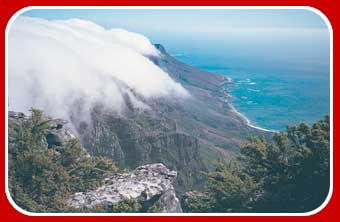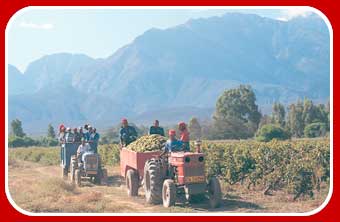| |
The
Land
South Africa is full
of dramatic scenery. The lowland plains that border the coast
are backed by a vast mountain range called 'the Great Escarpment'.
This horseshoe of mountains surrounds an interior plateau that
reaches an altitude of 3,408 m in the Drakensberg mountains.
Separated from the coast by the mountains, the interior plateau
is covered by grassland. It is also rich in natural resources,
including the world's largest and richest gold reserve.
| South
Africa's grasslands contain eight million hectares of
game reserves, including the Kruger National Park. |

� Panos Pictures |
The Climate
The 'Great Escarpment'
influences the climate. Moisture from the sea rises up the
mountain slopes bringing relief rainfall when it cools and
condenses. The mountains also create a 'rain shadow' on the
other side as the air dries and warms on its descent. Consequently,
much of the dry interior does not receive enough rain to grow
crops easily.
Moisture
rises from the sea to form a blanket of clouds over the
mountain tops.
This could lead to relief rainfall. |

� Sara Murray/Panos Pictures. |
South Africa's climate
is also influenced by the prevailing ocean currents that flow
along the 3,000 km of coastline, bringing different conditions
west and east. The cold Benguela current flows along the western
shores, creating a dry, cool climate. In contrast, conditions
on the east coast around Durban are hot and humid because of
the warm Agulhas current that moves southwards from the tropics
in the Indian ocean. Here, it is possible to grow tropical crops
like bananas and sugar cane. South African farmers are always
vulnerable to the unpredictable pattern of the weather. In 1999,
the weather was unusually dry and crop harvests were smaller
than usual, but in 2000, particularly wet weather brought widespread
flooding.
Cape Town:
wine Country in a Mediterranean Climate
The people of Cape Town on South Africa's south-west tip experience
a Mediterranean climate. Their summers (our winters) are warm
but during their winter, a local wind blowing off the sea
prevents a chill. Even though it also brings some rain, local
people have nicknamed the wind, "the Cape Doctor" because
they say it keeps colds and flu away.
| The
grape vineyards on the slopes around Cape Town are suited
to the Mediterranean climate and fertile soils. During
the 1990's, wine exports from South Africa tripled. |

�
Caroline Penn/Panos
Pictures. |
 to
see a climate graph for Cape Town to
see a climate graph for Cape Town
|
|





